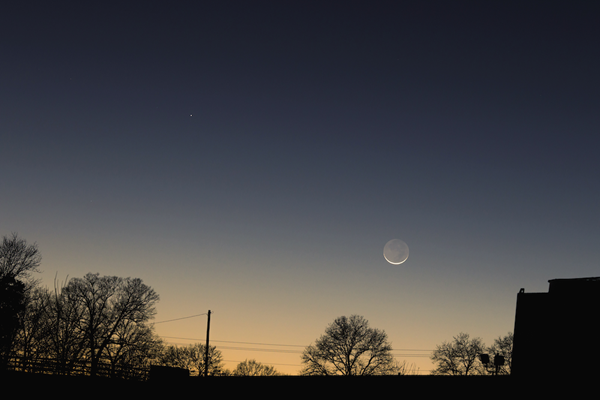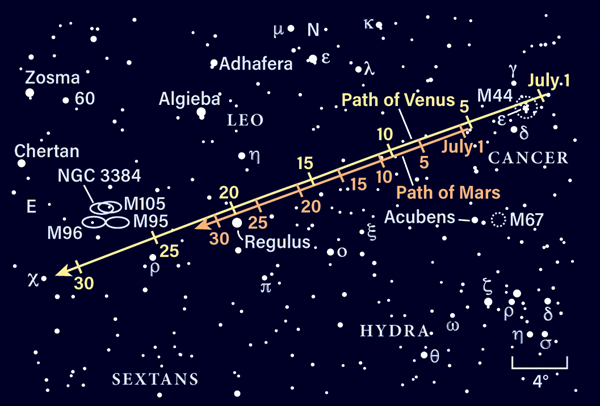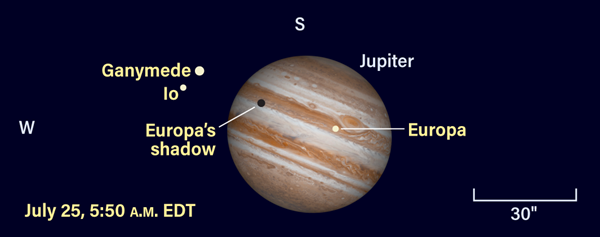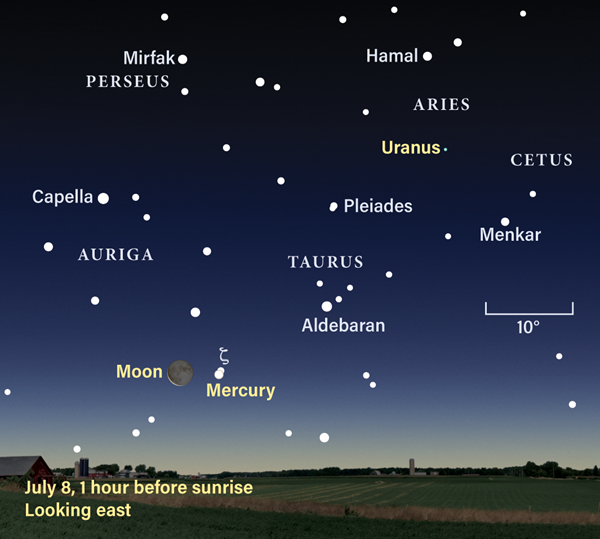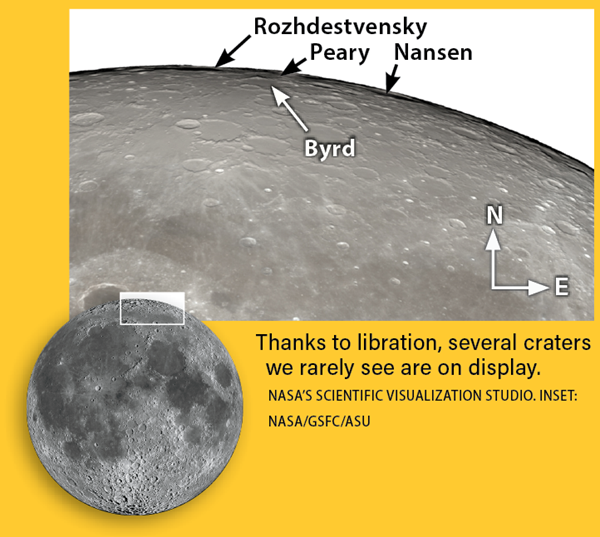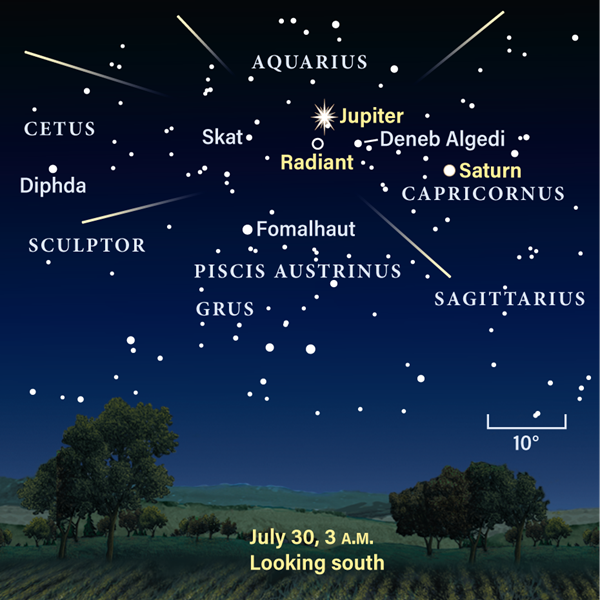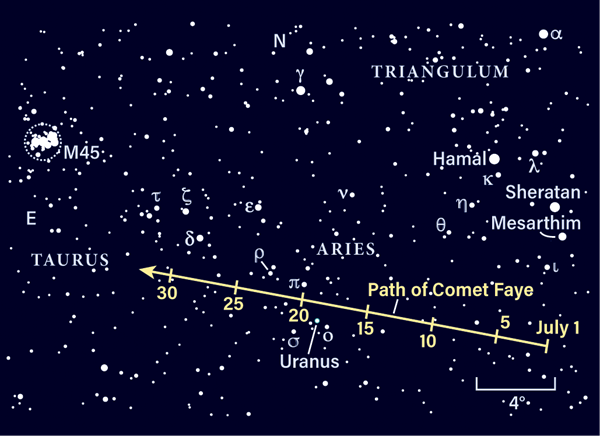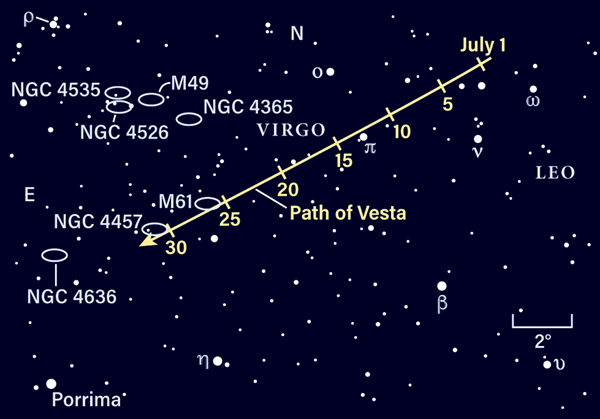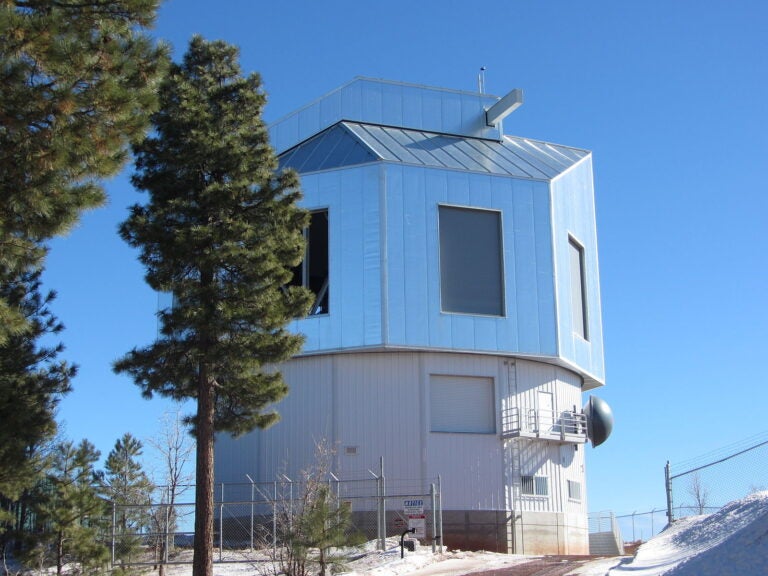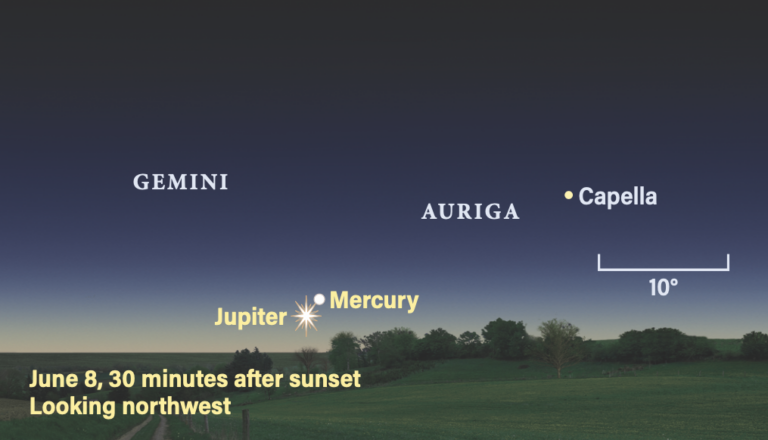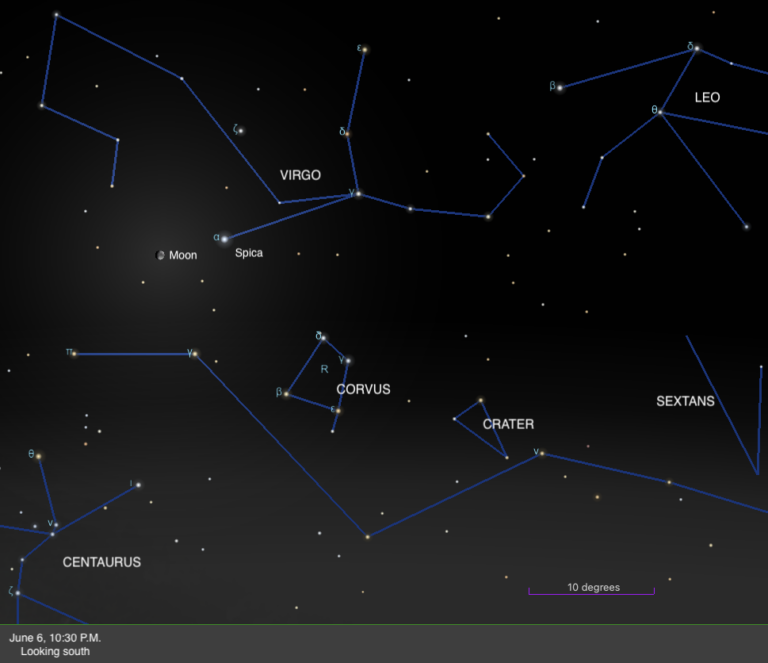The shorter summer evenings still offer a wide range of planetary events for casual and serious observers alike. Venus dominates the evening sky, while Mars lingers in twilight as well. The midnight sky brings Jupiter and Saturn into view as they approach their best appearance for the year. Binoculars can track down Uranus and Neptune, both of which lie near field stars. Mercury makes an appearance as dawn breaks; see if you can catch it before the Sun bakes the sky blue.
July 1st provides a spectacular view of Venus, visible as a brilliant magnitude –3.9 object low in the western sky soon after sunset. Don’t miss the opportunity to take a look with a pair of binoculars. If the sky is dark enough and it’s not too hazy, you might make out the star cluster popularly known as the Beehive (M44), or Praesepe, in Cancer the Crab. It appears just 1.5° east of Venus. Look also for Mars, 7° east of Venus and shining at magnitude 1.8.
An even more spectacular view occurs the next evening, July 2, when Venus lies within the northern regions of M44. Venus sets around 10 P.M. local time; 30 minutes earlier, the twilight glow diminishes the cluster’s visibility, but it’s worth trying to view or photograph this beautiful scene. The Beehive’s brightest stars are 6th magnitude and the cluster’s total apparent magnitude is 3.7, so it may only appear as a faint mistiness in twilight. Find a location with a clear western horizon where you can safely set up your telescope for a fleeting — but hopefully perfect — view of the planet apparently embedded in this distant star cluster.
Venus displays an 89-percent-lit gibbous disk through a telescope and spans 11″. It crosses into Leo July 11, when a two-day-old crescent Moon joins it in the western sky and Mars and Venus are separated by less than 1°. The following evening (July 12), the Moon appears east of the pair, with Mars nearly 33′ due south of Venus. Both planets are visible together in a telescopic field of view, which will show Mars spanning slightly less than one-third Venus’ width. Such conjunctions are line-of-sight effects — in reality, Mars lies about 1 astronomical unit (the average Earth-Sun distance, or approximately 93 million miles) farther from our planet than Venus, which itself stands 1.4 astronomical units from Earth. (For more on this event, see “Venus and Mars meet up” on page 50.)
Venus is 1.1° north of Regulus, Leo’s brightest star, on July 21. It is followed eight days later by Mars. Venus continues across Leo through the last 10 days of the month and spans nearly 13″ by the end of July. Mars stands near Regulus on July 28 and 29; it appears slightly northwest of the star on the first evening and slightly northeast the next night. They are closest on the 29th as seen from the Americas, separated by 38′.
Saturn is within a month of its Aug. 2 opposition, and rises around 10 P.M. local time on July 1. It’s well placed — more than 16° high at local midnight in the southeast — and reaches the meridian around 3 A.M. local time, making this the best time to view the ringed planet in early July. By the end of the month, it reaches the meridian about two hours earlier.
Occasionally Saturn passes a deep-sky object, but the brightness contrast makes viewing difficult. For example, Saturn slides 1′ due east of the magnitude 14 galaxy IC 1339 on July 4/5. Photographing the pair will prove exceedingly challenging, since Saturn will be overexposed in short shots but long exposures are required to capture the galaxy.
Saturn brightens from magnitude 0.3 to 0.1 by the end of July, dominating the constellation Capricornus the Sea Goat. Telescopic views reveal its 18″-diameter disk, encircled by the magnificent ring system spanning 42″ along its long axis and 12″ along the short axis. Saturn’s polar diameter of 17″ shows off more of the south polar area than in recent years.
Magnitude 8.5 Titan is an easy target for small scopes. It lies north of Saturn July 2 and 18, and south of the planet July 10 and 26. Three smaller, magnitude 10 moons orbit closer to Saturn: Tethys, Dione, and Rhea change relative positions hourly. Even fainter is magnitude 12 Enceladus, hugging the outer regions of Ring A.
Iapetus reaches western elongation July 4, sitting 9′ due west of Saturn near 10th magnitude. By its July 24th superior conjunction, it’s dimmed to near 11th magnitude.
We’re entering peak Jupiter viewing season for 2021. The giant planet rises in the hour before midnight on July 1 and by the end of twilight at the end of the month. This places it near the meridian in the early morning hours — the best time to view it. Jupiter is moving retrograde in Aquarius near its border with Capricornus and lies about 20° east of Saturn.
It’s a dominant object in this region of the sky, shining at magnitude –2.7 most of the month and reaching –2.8 by the end of July. Telescopic views will show a wide range of cloud features on its 48″-wide disk. These features move quickly with the planet’s rotation period of just under 10 hours. Two dark equatorial belts straddle the equator and carry with them dark and light regions, along with more spots and belts in the temperate regions.
Io, Europa, Ganymede and Callisto — Jupiter’s four major moons — wander to different positions each night. You can track them easily with a small telescope and follow the occasional transits of moons and their shadows. Moons also sometimes hide in or reappear from an eclipse behind Jupiter or its shadow, which extends away to the west of the planet before opposition.
A thrilling series of events occurs July 24/25. The shadow of Europa joins the largest moon, Ganymede, in a transit of Jupiter, while a short time later, Io enters an eclipse. Such simultaneous events are rare and fun to watch as orbital dynamics play out right in front of you. Note that some events are not visible from all locations in the U.S., so check the times for sunrise and the altitude of Jupiter at your location.
Neptune sits 12° due west of the Last Quarter Moon early on the morning of July 1. Binoculars are sufficient to detect the magnitude 7.7 planet. Located in eastern Aquarius, Neptune is moving retrograde, heading toward a September opposition. It rises around midnight and is best placed for viewing from 2 A.M. local time through dawn in early July, and from midnight through dawn late in the month. Neptune lurks 5.8° east of Phi (ϕ) Aquarii and due south of the Circlet in Pisces. It lies very near a slightly brighter field star (HIP 116402, magnitude 7.2) and appears like a double star under low magnification. Neptune’s motion relative to the field star is noticeable from night to night. The planet lies 4.1′ due south of this star on July 18 and continues westward, ending the month 14′ to its southwest. A gibbous Moon returns to Aquarius the morning of July 27, when Neptune stands 8° to its northeast.
Uranus is best viewed in the hour before dawn, high in the southeast among the faint stars of southern Aries. Binoculars will easily reach the magnitude 5.8 planet, although its exact location is tricky given the sparse star field. On July 1, Uranus is 12′ due north of magnitude 5.8 Omicron (ο) Arietis. Find Omicron by picking up 4th-magnitude Mu (μ) Ceti, the northernmost star in the head of Cetus the Whale, then moving due north past 38 Arietis (2° north of Mu) until you reach Omicron, 3° north of 38 Ari.
During July, Uranus treks northeastward and is nearly 1° from Omicron on July 31. It is then 14′ due north of a fainter (magnitude 6.7) field star. Through a telescope, Uranus reveals its planetary nature in the form of a 4″-wide blue-green disk. A waning crescent Moon lies in the vicinity the morning of July 4, when Uranus stands 4.5° to its northeast.
Mercury reaches greatest western elongation (22°) from the Sun on July 4, when it rises 80 minutes before sunrise. Its dim magnitude 0.5 will make it a challenging object low in the eastern sky — use Aldebaran in Taurus as a guide. The star rises half an hour earlier and sits 11.5° due west of the planet.
Mercury’s visibility improves even as its elongation shrinks because its brightness increases. Try on July 7, when it glows at magnitude 0.2 and stands 8° below the waning crescent Moon. Try again the next morning (July 8), when Mercury is 0.1 magnitude brighter and the exceedingly thin crescent Moon lies level with it above the horizon. Both rise 85 minutes before the Sun. An hour before sunrise, they stand 3.5° high in the east. Can you spot Zeta (ζ) Tauri 0.5° above Mercury?
Mercury is a lot brighter July 12, standing 3° high an hour before sunrise and magnitude –0.3. A week later (July 19), it has brightened to magnitude –1 but its separation from the Sun is declining. Now you have to look later — 45 minutes before sunrise — to see Mercury 3° high. It sinks quickly over the following week and becomes lost in twilight as it approaches next month’s superior conjunction.
Rising Moon: To the pole!
Will you be struck by lunar gold near Full Moon? As it tracks low in the sky, blue light gets scattered away by the longer path through Earth’s atmosphere, producing a warm yellow glow. You may additionally notice something unusual: Mare Crisium on the eastern limb almost looks like it’s on the equator. And there’s all this “extra” light-hued terrain near the north pole!
The Moon slowly bobs up and down across the ecliptic — the imaginary plane of our solar system — and hits the lowest point on the 22nd. From our earthbound perspective, we get to see a little past the top of Luna’s head and down the farside — astronomers call this a northern libration. If you’re up for a little adventure, let’s embark on a trek to the north pole.
Features close to the lunar north pole are named for great explorers of past centuries. Two main ones are named for American adventurers Richard Byrd and Robert Peary. The brilliantly rayed crater Anaxagoras is useful as a reference marker. Smack below the northern limb you can identify Byrd as the larger, flat, fully illuminated oval.
Nicely sunlit is Byrd’s back wall, almost indistinguishable from Peary’s outer southern flank. And what a fantastic 3D view we get, thanks to the shadow placement. Peer past Peary’s parapets into its partially shadowed crater, right up to the back wall. Immediately behind that lies the pole itself, in shadow. But there’s more: The outer rim of Rozhdestvensky is lit up. Named for a Soviet physicist, this feature is at 87° latitude on the lunar farside! Off to the east (right) down the limb a bit is another light-dark pair: the walls of Nansen, named after the Norwegian explorer.
The up-down cycle of 27.2 days leaves us one more chance Aug. 21st and 22nd, before it drifts out of sync with the period of the Moon’s Full phase.
Meteor Watch: Scan the horizon
Meteor showers are fickle things. We can only predict expected rates per hour, which are heavily dependent on your location, the amount of street lighting and moonlight, and the height of the radiant above the horizon.
All this means that predicted rates are usually tempered a great deal. Such is the fate of the Southern Delta Aquariids, which can produce 20 to 25 meteors per hour on a good night with the radiant overhead. But for those at mid-northern latitudes, the radiant climbs only to 30° in altitude, reducing the expected number to 10 per hour. A waning gibbous Moon provides a lot of light on the peak date of July 30, limiting visible meteors to the brightest ones.
Yet one brilliant meteor is truly memorable and it’s why observers enjoy any shower. Jupiter sits 4° north of the radiant, which rises before local midnight. The shower is active from July 12 to Aug. 23 — a wide range, allowing observers to look for shower members when the Moon is out of the way.
Comet Search: Higher flier
Clear summer nights often leave you wanting more. If your latitude only gives you four hours of darkness, going ‘till 3 A.M. is worth the preparation. Several periodic comets float in the predawn sky: 15P/Finlay and 8P/Tuttle are low in the horizon haze, while 4P/Faye glides above.
Dark country skies are needed to pick up Faye’s 10th-magnitude glow in a 4-inch scope. An 8-incher should reveal a stubby tail off to the north, while the southern flank sports a more well-defined boundary. Although Faye returns every 7.5 years, we only get a decent look every 15, because that extra six months puts Earth on the far side of the Sun in our January location every other orbit.
Faye never comes inside Mars’ orbit, so a slightly closer opposition makes a huge difference in peak magnitude. Just how close is not precisely known. Jupiter’s gravitational tugs, added to the jet effects of outgassing, creates uncertainty in the comet’s position and perihelion date until we nail it on an image.
Locating Asteroids: Suburban sighting
As darkness falls, bright blue-white Regulus and Spica twinkle in the southwest. Halfway between them and a few degrees above, magnitude 7.4 asteroid 4 Vesta runs eastward against the stars at ½° per night, slowly dropping behind Earth’s 1° per day. Virgo is an ideal place to track it: the constellation sports a scattering of 3rd- to 6th-magnitude landmarks and uncrowded views with only one or two field stars brighter than Vesta.
Still easy from the suburbs in the smallest of scopes, Vesta is becoming challenging in binoculars under the veil of light pollution. With a handful of stars plotted on a logsheet, you can readily see which dot moves night to night. If you pick Pi (π) Virginis as your anchor, for five nights centered on the 13th, Vesta will be less than 1° away. The First Quarter Moon passes by on the 15th without issue.
To see Vesta shift against the background stars in one observing session, the 1st, 13th, and 19th offer great backdrops. Supernova hunters will skip a heartbeat on the 27th, when Vesta slips 20′ south of majestic spiral M61. If you’re finishing off your Virgo Messiers on Saturday the 31st, drop in on Vesta posing next to bright NGC 4457, just a few degrees southeast of M61.

